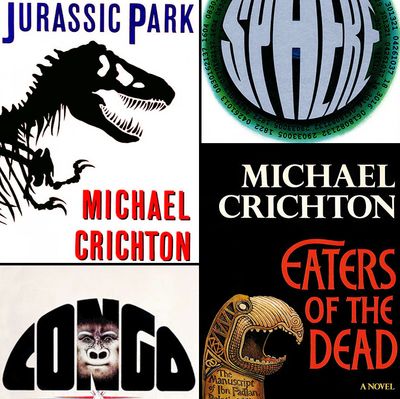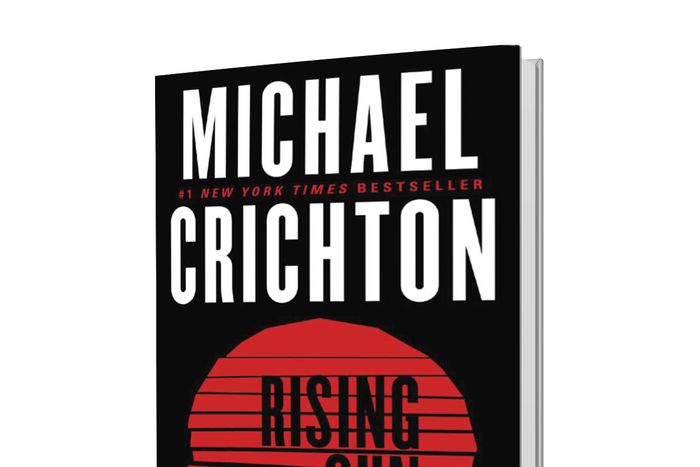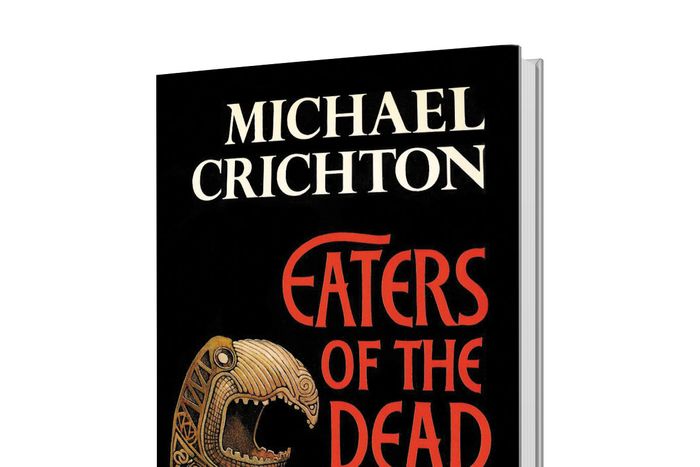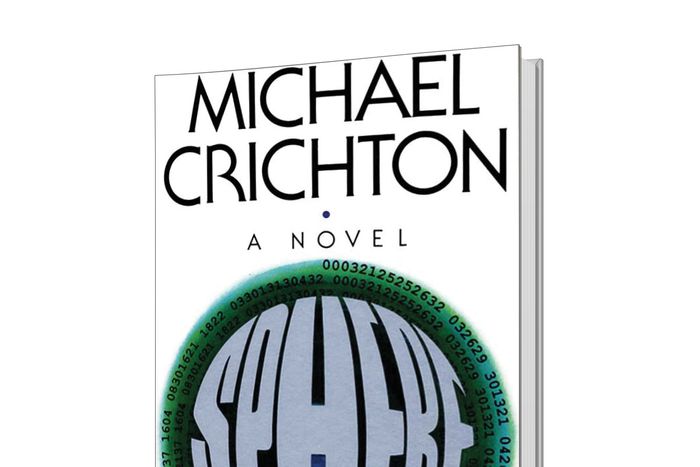When Jurassic World finally roars to life on June 12, itÔÇÖll mark the latest emergence of the dinos-run-amok scenario created by Michael Crichton in his 1990 novel Jurassic Park. While that book is probably the authorÔÇÖs most famous work, itÔÇÖs also just the tip of his high-tech, high-concept, popular-thriller iceberg.
Like his fellow superstar novelists Tom Clancy (military technology) and John Grisham (lawyers), Crichton had his own distinctive and incredibly page-turning shtick: meticulously researched settings that involve a crack team of experts combating a wild social or scientific breakthrough of some kind or another, be it a hungry T. rex or a sexually dominating female boss. (ThereÔÇÖs a serious conservative streak running through his novels.) Crichton died at age 66 in 2008, which means weÔÇÖll never get to see what exotic adventures this intellectually curious and endlessly imaginative ÔÇö if exuberantly pedantic ÔÇö guy would make of, say, social media or Bitcoin mining, but he left more than enough behind.
In addition to his novels, the Harvard-trained M.D. also released four books of nonfiction, as well as a couple early efforts under pseudonyms, and his last book,┬áMicro, was finished by Richard Preston. Those are worth investigating, but not here: WeÔÇÖre solely ranking the novels published under CrichtonÔÇÖs own name, from worst to best, which, as youÔÇÖll see, is plenty. So letÔÇÖs go.
CrichtonÔÇÖs lurid whodunit is a thoroughly paranoid wannabe-expos├® of Japanese business development in smoggy, fast-paced, traffic-clogged, corrupt Los Angeles in the early ÔÇÖ90s, peopled with a cast of sleazy journalists and lawyers, sex-fiend politicians, smug celebrities, tittering secretaries, and drugged-out models. ItÔÇÖs all in service of hammering home the idea that, in Japan, business is war. Sort of amazingly, in hindsight, the book includes lines like, ÔÇ£There are many reasons to dislike the Japanese.ÔÇØ Once in a while, Crichton drops an observation that piques interest (apparently, the Japanese ÔÇ£never accepted Freud or ChristianityÔÇØ), but the traces of curiosity here are overwhelmed by oodles of nasty xenophobia.
ItÔÇÖs up to resident sempai Captain John Connor, a retired member of the LAPD helping a younger prot├®g├® solve a kinky murder, to bring those Japanese usurpers to justice. The sleuthing is a platform for CrichtonÔÇÖs sledgehammer analysis of international relations. (He insistently knows what the Japanese are.) Despite all the Japanese-are-kicking-our-asses fearmongering, the bookÔÇÖs propulsive series of twists and deductions and wild setpieces can be entertaining: YouÔÇÖll enjoy the secret lab beneath a childrenÔÇÖs skating rink where an illicit videotape of the murder is analyzed frame by frame. But CrichtonÔÇÖs warning at the end that America must wake up to ÔÇ£see Japan clearlyÔÇØ as a warring competitor is an example of what makes the whole thing sort of off-putting.
Photo: Knopf
Like Rising Sun, State of Fear grabs your attention with an over-the-top mix of sex and violence: It opens with a seductive ecoterrorist paralyzing her new lover, a tsunami researcher, with a tiny poison octopus that leaves a ÔÇ£blue ring of death.ÔÇØ The environmentalists here are an international secret conspiracy of well-funded thugs who wield youthful idealism, scorpions, and weather (yes, weather) against their foes, using storm-manipulating rockets to convince the public with their manmade natural disasters that climate change is real. The hero is John Kenner ÔÇö an MIT prof who also happens to be an international law-enforcing super-spy ÔÇö who recruits a team of accomplices with some windy speechifying about the bogusness of climate change.
State of Fear is Crichton at his most cynical and snide, but it can be pleasurable to see how far he takes his seething anti-global-warming spiel, and all the inventive ways he can pad it with data and charts. Every plane ride in CrichtonÔÇÖs most globetrotting adventure is an excuse for an extravagantly detailed lecture, complete with bar graphs. But at 600-plus pages, the hectoring grows tiresome, and the book piles on the red herrings, near-death escapes, and unbelievable acts of decoding. ItÔÇÖs hard not to throw up your hands when KennerÔÇÖs team finds a crucial secret piece of paper in the battery compartment of a remote control by analyzing a cryptic Buddhist proverb.
Photo: Harper Collins
This was CrichtonÔÇÖs second novel in a row, after Eaters of the Dead, to deal with a mysterious primitive group terrorizing the forces of civilization, and his first book of many to rely on the close analysis of surveillance footage to reveal its all-important information. In this case, the info involves deadly primates with excellent communication skills whoÔÇÖve been trained to guard valuable diamond mines deep in the jungle of Zaire, in a place called the Lost City of Zinj, which we learn rivals the Hotel California for maximum you-can-never-leave ominousness. Congo takes a while to get going ÔÇö with a lot of plane rides and detailed explanations of things like solar flares or the histories of military computing and African conquest ÔÇö before a group of scientists, diamond miners, and one super-smart gorilla named Amy finally get to olÔÇÖ Zinj. There are lots of lengthy, technically detailed passages that do a lot of huffing and puffing to teach us that, hey, those diamond things are pretty valuable ÔÇö so much so that our underdogs are in a race against a major consortium to find the treasure. But when things threaten to get too explain-y, Crichton is good to throw in stuff like an earthquake, a lightning storm, a volcano overflowing with blue diamonds, cannibals, and the odd bout of human-versus-super-ape techno-warfare to keep your attention. Throughout Congo Crichton wonders, interestingly, about the markers of difference and similarity between humankind and other closely related species, emotionally and intellectually, and also looks at the difference between animals in captivity and in the wild. As such, thereÔÇÖs enough nature-versus-nurture and civilization-versus-wilderness questions to whet your anthropological appetite, but ultimately, your enjoyment of the novel may depend on how much you want to know about AmyÔÇÖs dietary and potty needs.
Photo: Knopf
Crichton followed Rising Sun with an even more sexually explicit story about the ruthless high-tech world of the early ÔÇÖ90s. The plot deals with a sexual harassment suit at DigiCom, an insanely high-strung software company ÔÇö one thatÔÇÖs busy making sure its breakthrough virtual-reality units donÔÇÖt make potential investors vomit. This time around, instead of laying the blame for big-money malfeasance on the Japanese, Crichton invents a sexily manipulative corporate-ladder-climbing monster named Meredith whoÔÇÖs attempting to wrongfully pin harassment charges on innocent manager Tom, and then milks the battle-of-the-sexes titillation ÔÇö hard.
 
Twenty-one years on, Disclosure has some time-capsule charm, as it harkens back to the CD-ROM days and name-drops CompuSoft, Symantec, and Bill Gates. We even get a character explaining that the internet is ÔÇ£the vast worldwide computer network.ÔÇØ Beyond that, there are some worthwhile considerations about creepy hierarchies of fear and blind protection of power ÔÇö Disclosure sure is good at steeping us in corporate hell. But Michael CrichtonÔÇÖs argument that power is sexless in todayÔÇÖs workplace (ÔÇ£neither male nor female,ÔÇØ as an opening quotation from late Washington Post publisher Katherine Graham puts it) sure feels like a poor-us-white-dudes-in-power complaint. ÔÇ£There were new rules now, and every man knew them,ÔÇØ MeredithÔÇÖs victim Tom laments, as he visits other men against whom this she-monster has used her wiles to secure her corporate position, while at the same time hiding her lame executive abilities. Sure, there are deficiencies in our understanding of the dynamics of sexual harassment that this book tries to entertainingly rectify, but ultimately, itÔÇÖs a problematic ÔÇö though at times compelling ÔÇö inner voice of male victimhood that guides us through Disclosure.
Photo: Knopf
CrichtonÔÇÖs sequel to Jurassic Park finds some of the Gore-Tex-clad characters from its predecessor returning to remote Costa Rican climes in search of another secret manufactured prehistoric civilization: the InGen corporationÔÇÖs own sequel to its first park, the straightforwardly named Site B. As per usual, some folks want to study the site, while others want to exploit it, and the story explicitly attempts to take us to ÔÇ£the edge of chaosÔÇØ (as the prologue is titled), fleshing out CrichtonÔÇÖs fascination with ÔÇ£complexity theoryÔÇØ and evolutionary and extinction arguments while thrilling us by returning to the cozily horrific world of dinosaurs. ThereÔÇÖs lots of entertaining pooh-poohing and one-upsmanship among the paleontologists, and loads of minutely detailed lessons about prehistoric creatures ÔÇö if youÔÇÖre not sure whether or not youÔÇÖre looking at a raptor, just check to see if the dinoÔÇÖs ÔÇ£antorbital fenestraeÔÇØ is ÔÇ£too rostral.ÔÇØ Jurassic Park mathematician Ian Malcolm returns to spit knowledge on just about any topic, especially when shutting down his new rival, the know-it-all upstart paleontologist Dr. Richard Levine. ÔÇ£The characteristic human trait is not awareness,ÔÇØ Malcolm explains, ÔÇ£but conformity, and the characteristic result is religious warfare.ÔÇØ Now you know.
 
The human baddies are some of CrichtonÔÇÖs most grandiose and idiotic; the egg-thieving geneticist Lewis ÔÇ£the UndertakerÔÇØ Dodgson literally hisses when he speaks, saying things like, ÔÇ£These animals are totally exploitable,ÔÇØ and wrongfully expects to stop T. rex attacks with piercing sounds. CrichtonÔÇÖs children characters seem like they could win the Hunger Games. Assistant paleontologist and seventh-grader Kelly is handed a shotgun by her Jane GoodallÔÇôlike animal-behaviorist hero, Dr. Sarah Harding, and sure enough can easily blast raptors from atop a whizzing motorcycle. ItÔÇÖs not totally surprising when the archvillains are picked off one by one by dinosaurs, more and more brutally, but as in the original Jurassic Park, the heart still quickens when the carnivores show up and do, well, anything. Crichton had an undeniable knack for suspenseful setpieces, and the one that has a Tyrannosaur swat a trailer full of people hanging off a literal cliff does the trick.
Photo: Knopf
In yet another Crichton novel about nefarious corporate behavior, Casey Singleton, the PR head of an American airplane manufacturer, has to investigate what ÔÇ£event cascadeÔÇØ led to one of its prized machines ÔÇ£porpoisingÔÇØ in the air, killing several people, ideally proving that it wasnÔÇÖt responsible to seal a huge deal with China. Was it uncontrolled slat deployment, fatigue cracks, a locking pin, a counterfeit part, a proximity sensor? Gah!
 
Airframe gives Crichton another chance to return to one of his favorite themes: the inevitable chaos of all complex systems, and he handles the ins and outs of plane manufacturing with aplomb, efficiently provoking awe and fear about the intricate and fallible design of quarter-million-pound machines. It could be an aspiring engineer or mechanicÔÇÖs favorite Crichton, and ÔÇö if youÔÇÖre susceptible to such things ÔÇö it could inspire more mid-flight worries than that classic Twilight Zone episode about the airplane gremlin.
 
ThereÔÇÖs plenty in here about the specifics of airplane manufacturing, and the novel is also a worthwhile look at how a company investigates and lays blame for a complicated event. Good PR rules all, it seems, with some excess cynicism reserved for journalists, a favorite Crichton punching bag. The climactic showdown between the press and the airplane company for the ÔÇ£true meaningÔÇØ of the story, involving two rivals strapped to the faulty airplane as it re-creates the crash conditions, achieves genuine liftoff. But sometimes we learn a thing or three too much about planes, and the story gets sluggish, occasionally absurd. Unions, for example, are presented as mobs of wrench-throwing goons, and when a journalist pukes during the climactic test flight, Airframe feels like another Crichton revenge fantasy, albeit one that gets pretty lively.
Crichton finished his long-gestating pirate adventure and final completed novel, one of this techno-futuristÔÇÖs rare forays into the past, while working on Next. And just as Next deals with the problems of labeling genes, Pirate Latitudes deals with the problems of labeling colonial seafarers as it explores the nasty grey areas of 17th-century conquest: Are Captain Charles Hunter and his crew ÔÇ£piratesÔÇØ or ÔÇ£privateers,ÔÇØ staking legal claims, or unlawfully pilfering from each other, explorers or exploiters?
Thankfully, thereÔÇÖs plenty of Caribbean-based adventure and gory vengeance to offset all the taxonomy questions. HunterÔÇÖs band of rogues undertake a perilous mission to attack and plunder an invulnerable Spanish fortress manned by the legendary ├£ber-dastard Cazalla ÔÇö itÔÇÖs ÔÇ£the most extraordinary privateering expedition in the century since Drake attacked Panama.ÔÇØ ThereÔÇÖs also bawdy sailor-speak and well-researched weapons history galore. French grenades, rat-intestine fuses, cannons, crossbows ÔÇö you want it, you got it. The book isnÔÇÖt quite as provocative as CrichtonÔÇÖs sci-fi, but the author makes up for it with a many-tentacled kraken, a gripping cannon battle in a place called Monkey Bay (followed closely by a hurricane and an escape from cannibals), and the general suggestion that the dangers of the deep sea are fathomless.
Photo: Harper Collins
CrichtonÔÇÖs riff on Beowulf begins with an expository journey of Vikings off to face an unnamable enemy. But rather than the enigmatic primates of Congo or Next, our Nordic heroes must go against an ancient humanoid species capable of resembling a glowworm dragon, among other fantastical things. Along the way, Crichton gives us anthropological tidbits on a variety of tribes encountered, like the Oguz, who, youÔÇÖll be fascinated to learn, never bathe after ejaculation. The repetitive trek across river after river with lots of cooking and traveling and celebrations is initially stultifying, but Eaters of the Dead eventually builds serious tension by pitting its inexperienced and sheepish narrator, the stranger-in-a-strange-place Arabic swordsman, Ahmad ibn Fadlan, against a shape-shifting foe. From the first battle against a stinky black mist onwards, the book gets more and more exciting, especially if you like your evil pure and your warriors stoic.
Photo: Knopf
Timeline opens with a compellingly mysterious image: A strange, sickly robed figure in Nikes muttering John Denver lyrics appears on the desert highway during a coupleÔÇÖs road trip. It gets weirder from there. A group of modern-day historians travel back in time to 14th-century France to rescue a beloved prof, and they encounter that landÔÇÖs alternatively brutal and charming ambience, forced to joust and stab and romance their way back home.
 
Any other writer might call whatÔÇÖs going on here ÔÇ£time travel.ÔÇØ Crichton dubs it ÔÇ£orthogonal multiverse coordinate changeÔÇØ ÔÇö and mashes that OMCC together with medieval fantasy in this, his most decapitation-heavy book. The results are cool: Using the 32 quantum states of an electron (instead of merely two, like the rest of us), late-20th century scientists interfere with photons from other universes to travel through ÔÇ£wormhole connections in quantum foam.ÔÇØ Whatever it means, itÔÇÖs neat, and the trips back in time have a pumped-up Star Trek transporter vibe.
 
As far as the educational by-product that Crichton is so good at delivering, well, did you know that castle-dwellers were really neat freaks who rolled their chain mail in sand to get rid of dust? Or that you could ignite medieval gunpowder with spit? Neither did the modern-day folks in Timeline. Curl up with a glass of Bordeaux and learn something fun.
Photo: Harper Collins
Prey is another one about a biotechnology firm, this one staffed by overtaxed, Sun ChipsÔÇômunching, Diet CokeÔÇôguzzling workers busy making dangerously unpredictable forms of artificial intelligence at a VC-funded start-up called Xymos. This oneÔÇÖs set in the spiderÔÇÖs web of Silicon Valley, so more lattes are consumed per page than in any other Crichton. ItÔÇÖs the authorÔÇÖs effective return to the minuscule-but-deadly substance narrative of his earlier The Andromeda Strain, with bacteria capable of entering and disrupting ÔÇ£the cytoplasm of cardiac cells,ÔÇØ which, of course, is a horrendously bad thing. The unholy combination here of genetic engineering and nanotechnology provides maximum creep-out: The nemesis, a rapidly adapting bioswarm (a ÔÇ£mechanical plagueÔÇØ), is a potent metaphor for the hazards of biotechnology and the runaway train of evolution. It also begs the eternal question: WhatÔÇÖs best for combatting a bioswarm? The scientists responsible for tracking and destroying the nanoswarms eventually settle on dirtbikes, hacked Windex, a fecal-smelling concoction, and, in a pinch, bombs.
 
Aside from the mechanical plague, Prey has a bunch of other memorable images. ThereÔÇÖs a molecular assembly line that looks like a giant liquid octopus with fractal architecture and diamondoid coating thatÔÇÖs also an unstoppable military helicopter, an approximate version of a corrupt character named Ricky thatÔÇÖs made out of shape-shifting swarm particles, and black rivers of swarm interrupting kisses between scientists. Maybe the only reason Hollywood hasnÔÇÖt adapted this one is because swarms arenÔÇÖt as easy on the eyes as apes or dinosaurs.
Photo: Harper Collins
Forget Congo: This is CrichtonÔÇÖs ultimate talking-chimp story. A tale of transgenic wrongdoing (among many other things), itÔÇÖs way weirder than its predecessor, without the clear plot thread of the authorÔÇÖs other novels, and it improves from a slightly murky start to thoughtful speculations about the worrisome vagueness of gene patenting and the potential use or misuse of human tissues by corporations and academies. The book shows CrichtonÔÇÖs vibrant curiosity for these issues rather than trotting out an ossified position like he did in State of Fear. ItÔÇÖs also got fun monkey-in-the-household shenanigans and a variety of strange animals to keep us amused: a foulmouthed parrot, a purple glow-in-the-dark turtle, and giant cockroach pets. Sure, itÔÇÖs a mishmash of familiar Crichton tropes (stolen embryos, revealing surveillance footage, ÔÇ£complexity theoryÔÇØ), but itÔÇÖs the author at his most unpredictable and loose and nutty.
Photo: Knopf
CrichtonÔÇÖs mind-control classic pissed off the American Epilepsy Foundation with its tale of scientistsÔÇÖ efforts to curb psychomotor epilepsy patient Harold BensonÔÇÖs ÔÇ£psychotic mentation.ÔÇØ (ThatÔÇÖs Crichton-speak for unwitting episodes of sexual aggression and violence.) This Jekyll and Hyde update features myriad burgeoning computer-age anxieties about a machine takeover bubbling up, with impeccable med-tech details ÔÇö each EEG printout and leering doctor is in its right place, as BensonÔÇÖs state-of-the-art brain-electrode implants fail to whip him into shape, instead prompting even more brutally murderous rampaging. Crichton demonstrates his skill at taking an ultracontrolled environment (here, the ÔÇ£Neuro-Psychiatric ServiceÔÇØ ward) and mussing its hair, showing what happens when all the correctly implemented data in the world wonÔÇÖt stop an angry guy from mashing in peopleÔÇÖs faces.
Photo: Knopf
CrichtonÔÇÖs first ÔÇ£Michael CrichtonÔÇØ novel (that is, not written under one of the rotating aliases that he used to kick off his career) is a compelling medical mystery that begins with an apology in the authorÔÇÖs foreword that itÔÇÖs ÔÇ£a rather technical narrative.ÔÇØ For the most part, you wonÔÇÖt mind the obsessive attention to detail, not when Dr. Jeremy Stone, a young Nobel laureate, is busy saving the world from alien bacteria (ÔÇ£a unicellular organism, coccobacillary in shape, gram-negative, coagulase, and triokinase-positiveÔÇØ). How does he do it? By deciphering secret codes, running diagnostics on weird hemoglobin, using zippy techniques like X-ray crystallography ÔÇö you get the drift.
 
Andromeda Strain wisely preys on a blend of late-ÔÇÖ60s fears about germs, nukes, and interplanetary travel, and gives us the ultimate neat-freak creep-fest as a crack team of pathologists in pink onesies (hereÔÇÖs the guy who discovered Brazilian tapeworm; thereÔÇÖs a doc prominent in the ÔÇ£hot fieldÔÇØ of staph infection) assemble to destroy this super-bacteria while making loads of queasy stomach-illness in-jokes. Plus, Crichton gives us the perfect psychedelic-era medical response to an ulcer patient who survives the killer strain and might lead to a cure: ÔÇ£The man was acid.ÔÇØ The book doesnÔÇÖt skimp on menacing secret intragovernmental missives, mysteries of the organism, or elaborate quarantine and autopsy procedures, and only goes wobbly at the end, when it relies on a hackneyed (but forgivably goofy) self-destruct countdown sequence that a hero must stop, in ultra-slow-motion, by turning a key while being peppered with automated poison darts and warned of his impending doom by a sultry female computer voice.
Photo: Knopf
Oh, the whimsical use of genetic engineering by billionaires, and the unknown adventures in science that take place behind closed doors: Jurassic Park is museum-curation and amusement-park exploitation at their most horrifying, and CrichtonÔÇÖs big goldmine. (It was also a real contender for the top spot on this list.) It begins with the authorÔÇÖs strongest horror ÔÇö a series of mysterious attacks and desperate responses in Costa Rica ÔÇö and it has his most well-executed use of the suggestion of violence, as an unseen but devastatingly implied raptor attack on a child gets us eager for various combinations of dinosaur-versus-human. The book gets a tad slow when detailing Jurassic-era plants or paleontologist neuroses, but picks up whenever the dinos arrive, while sending thoughtful (if overlong) discussions of perpetual change and instability our way via mathematician character Ian MalcolmÔÇÖs ÔÇ£chaos theoryÔÇØ ramblings. (ÔÇ£WobblesÔÇØ are essential to a system, huh?)
 
Jurassic Park is also CrichtonÔÇÖs first of several books to really employ imperiled children as a chief part of the suspense engine (as well as the usual power outages and pitch-black grapplings), and relies on a few other well-worn ÔÇö and well-deployed ÔÇö devices to ratchet up the tension and then offer relief. Codes are elaborately deciphered, escapes occur via river raft, our casually rugged heroes outsmart surprisingly smart dinosaurs, and plenty of cowards and villains meet their brutal deaths. The book gets a lot of mileage out of the strength of its central conceit (what if dinosaurs came back?), but you canÔÇÖt deny its fun quotient, and Crichton made sure to leave plenty of room for a sequel.
Photo: Knopf
CrichtonÔÇÖs most mysterious plot again involves newly discovered entities in a very remote place, as a team of terrified elite scientists investigate the appearance of an unidentified vessel in deep waters somewhere between Samoa and Fiji thatÔÇÖs scaring the hell out of the worldÔÇÖs militaries. This has lots of fun speculations about how our governments would prepare for a possible alien encounter, chief among them sending a bunch of geniuses in blue polyester jumpsuits into a problem-solving incubator to figure it out. What is ÔÇ£itÔÇØ? ÔÇ£Unquestionably,ÔÇØ one of the brainiacs helpfully explains, ÔÇ£the most important archeological site in the history of mankind.ÔÇØ
 
SphereÔÇÖs inter-team banter and tensions are some of CrichtonÔÇÖs liveliest head-games, particularly when they occur between hubristic math prodigy Harry Adams and the arrogantly racist scientist Ted Fielding. For a story about a giant metal sphere, the suspense builds organically, and the setpieces are striking ÔÇö the mysterious ship has a giant room with its own weather system that you have to take a conveyor belt to get to. ThereÔÇÖs real excitement when the team is pitted against a variety of impossible blob-creatures and their own increasingly malleable (and terrifying) consciousnesses. Though itÔÇÖs a bit disappointing that the drama is resolved by simply blowing up the alien thing, the mutating hive-mind creature is CrichtonÔÇÖs richest creep-zone, and the blindness-about-ourselves and we-must-face-our-fears thematics have a strangely effective power-of-positive-thinking message. One quibble: Why doesnÔÇÖt anyone ever call the alien structure an ÔÇ£orbÔÇØ or a ÔÇ£ballÔÇØ?
Photo: Knopf
ItÔÇÖs not his best-known work, nor is it typical of his hallmark high-tech interests, but The Great Train Robbery is Crichton at his most enjoyable. The intricately plotted and charmingly slang-laden adventure shows the meticulous preparation that went into a notorious 1855 gold heist, in a period of history when lots of people, apparently, were ÔÇ£doing a bit of softÔÇØ (running elaborate cons) to get by. The story follows a ÔÇ£cracksman,ÔÇØ charismatic master thief Edward Pierce, and a ÔÇ£screwsman,ÔÇØ key copier Robert Agar, in LondonÔÇÖs world of ÔÇ£crushersÔÇØ versus ÔÇ£dippersÔÇØ who rely on the help of ÔÇ£judysÔÇØ to work a ÔÇ£bone lay.ÔÇØ WhatÔÇÖs all that mean? The fun is in finding out ÔÇö this is Crichton at his most energetically colorful; more than any of his books, you can sense the writer having fun with the subject matter. It also covers all the important Victorian crime-novel bases: railroads, slums, pubs, public hangings, venereal disease, and a wide variety of clever escapes from sticky situations. (Look out for the fantastic sequence where thieves use a coffin, Trojan horse style, to board and ransack the titular train.) The Great Train Robbery might not be the authorÔÇÖs most representative work ÔÇö thereÔÇÖs not nearly enough techno-jargon for that ÔÇö but, for our money, itÔÇÖs top-shelf Crichton.
Photo: Knopf


















